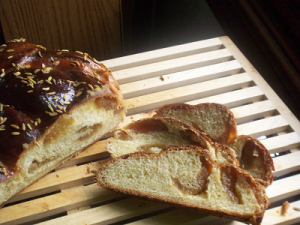Please scroll down for Italian translation
For my third and final version of Eleonora’s Sweet Shabbat Bread I used lemon marzipan, a confection that I usually make twice a year–for Purim and Pesach. It is a rather sweet filling, reminiscent of flavors from the culinary tradition of the Jews of Greece. I sprinkled the top of each loaf with fennel seeds as their fresh taste pairs well with the lemony filling.
Lemon Marzipan
Peels of 10–12 lemons (well scrubbed)
5 -1/2 cups finely ground almonds
2 cups sugar
1 cup water
juice of 1 lemon
1/4 tsp pure almond extract
Soak the lemon peels in a bowl with water to cover, keeping the bowl covered and stored in the refrigerator. Change the water 3–4 times during the day. On the third day, rinse the peels and put them in a saucepan with water to cover. Simmer on low heat until the peels are very soft, about 1 hour. Drain the peels and grind them to a paste in a food processor. Add the ground almonds and almond extract and process until well blended.
Boil sugar, lemon juice and water in a pan for about 10 minutes, until a thick syrup forms. Add the lemon-almond mixture and cook over low heat for 3-4 minutes, stirring vigorously, until the paste no longer sticks to the pan. Let cool. Be careful not to overcook the paste or it will be too dry.
Dough
I followed Eleonora’s recipe with no modifications. Divide the dough in 6 equal parts, roll each one in a long strip and spread with the marzipan, leaving a neat margin all around. Roll up jelly roll- style starting with one of the long sides, pinch well to seal.
Make two 3- strand braids, then coil each braid in a spiral as shown in the following picture:
Once the breads are light and puffy apply the egg wash (1 yolk mixed with 1 tbsp water), then sprinkle with fennel seed.
Bake in a preheated oven (350F) for about 30 minutes, until nice and golden. Cool on racks.
Here is a picture of a slice:
Italian version
La mia terza e ultima versione del Pane Dolce del Sabato ha un ripieno di marzapane al limone. Questo tipo di marzapane lo preparo normalmente due volte all’anno, per le Feste di Purim e Pesach. Il ripieno e’ decisamente dolce, e ricorda i sapori della tradizione degli Ebrei di Grecia. Sulle trecce ho cosparso dei semi di finocchio, perche’ il loro aroma fresco si sposa bene con quello del limone e delle mandorle.
Marzapane al limone
Bucce ben pulite di 10-12 limoni
500 g di mandorle macinate finissime
400 g zucchero
1/4 l acqua
succo di 1 limone
1/4 tsp estratto naturale di mandorla
Tenere le bucce a bagno per 3 giorni, in una ciotola coperta e tenuta in frigo, cambiando l’acqua 3-4 volte al giorno.
Il terzo giorno scolarle, metterle a cuocere coperte di acqua nuova, a fuoco basso, finche’ sono tenere, per circa 1 ora.
Scolarle bene, e ridurle in crema in un mixer. Aggiungervi le mandorle e l’estratto e amalgamare bene.
Portare a bollore l’acqua con zucchero e succo di limone e far cuocere per circa 10 minuti, finche’ si ha uno sciroppo spesso. Aggiungere il misto di mandorle e limone e cuocere per 3-4 minuti, finche’ la pasta si stacca dalle pareti della pentola. Non cuocere oltre o raffreddando si secchera’ troppo.
Impasto
Ho seguito la ricetta di Eleonora senza modifiche. Una volta pronto l’impasto si divide in 6 parti uguali, ciascuna si stende in una striscia e si spalma di marzapane, lasciando un po’ di margini. Arrotolare dal lato piu’ lungo e sigillare bene. Formare due trecce a tre capi e poi arrotolarle su se stesse a spirale, come nella foto:
Quando i pani sono ben lievitati (ci vuole un bel po’, perche’ l’impasto e’ ricco di olio, uova e zucchero), spennellarli di tuorlo misto ad acqua e spargervi i semi di finocchio. Infornare come da ricetta e raffreddare su una grata.
Foto dell’interno:






e stavolta, son senza parole.
e credimi, è un mezzo miracolo…
🙂
idem, come sopra.
mi domando se questo marzapane si potrà usare come ripieno per degli hamantashen. Mi fa una gola pazzesca.
non ci avevo mai pensato. Proviamo per il prossimo Purim? Di solito ne faccio semplicemente delle palline ( e delle formine, coi bambini) passtae poi in poco di zucchero a velo.